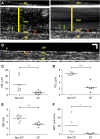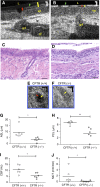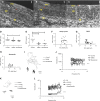A functional anatomic defect of the cystic fibrosis airway
- PMID: 25029666
- PMCID: PMC4214131
- DOI: 10.1164/rccm.201404-0670OC
A functional anatomic defect of the cystic fibrosis airway
Abstract
Rationale: The mechanisms underlying cystic fibrosis (CF) lung disease pathogenesis are unknown.
Objectives: To establish mechanisms linking anion transport with the functional microanatomy, we evaluated normal and CF piglet trachea as well as adult swine trachea in the presence of selective anion inhibitors.
Methods: We investigated airway functional microanatomy using microoptical coherence tomography, a new imaging modality that concurrently quantifies multiple functional parameters of airway epithelium in a colocalized fashion.
Measurements and main results: Tracheal explants from wild-type swine demonstrated a direct link between periciliary liquid (PCL) hydration and mucociliary transport (MCT) rates, a relationship frequently invoked but never experimentally confirmed. However, in CF airways this relationship was completely disrupted, with greater PCL depths associated with slowest transport rates. This disrupted relationship was recapitulated by selectively inhibiting bicarbonate transport in vitro and ex vivo. CF mucus exhibited increased viscosity in situ due to the absence of bicarbonate transport, explaining defective MCT that occurs even in the presence of adequate PCL hydration.
Conclusions: An inherent defect in CF airway surface liquid contributes to delayed MCT beyond that caused by airway dehydration alone and identifies a fundamental mechanism underlying the pathogenesis of CF lung disease in the absence of antecedent infection or inflammation.
Keywords: airway epithelium; cystic fibrosis; mucus transport; optical coherence tomography; viscosity.
Figures






Comment in
-
Measuring mucociliary transport and mucus properties in multiple regions of airway epithelial surfaces helps clarify cystic fibrosis defects.Am J Respir Crit Care Med. 2014 Aug 15;190(4):364-5. doi: 10.1164/rccm.201407-1247ED. Am J Respir Crit Care Med. 2014. PMID: 25127304 No abstract available.
References
-
- Rowe SM, Miller S, Sorscher EJ. Cystic fibrosis. N Engl J Med. 2005;352:1992–2001. - PubMed
-
- Quinton PM. Missing Cl conductance in cystic fibrosis. Am J Physiol. 1986;251:C649–C652. - PubMed
-
- Welsh MJ. An apical-membrane chloride channel in human tracheal epithelium. Science. 1986;232:1648–1650. - PubMed
Publication types
MeSH terms
Grants and funding
LinkOut - more resources
Full Text Sources
Other Literature Sources
Medical

